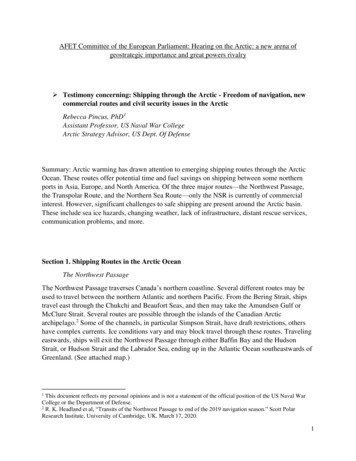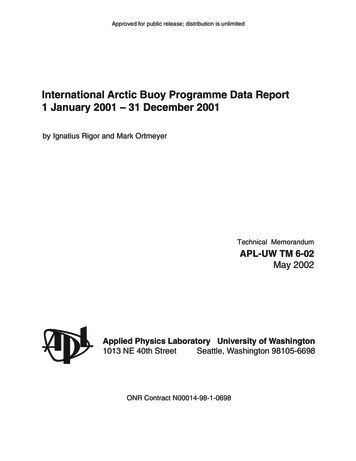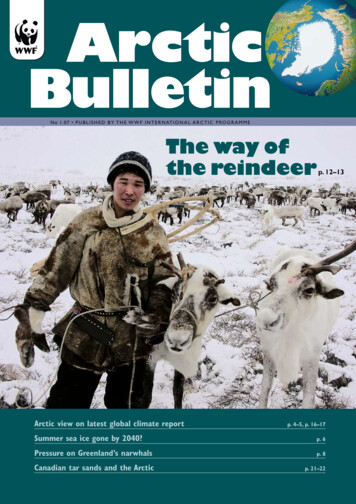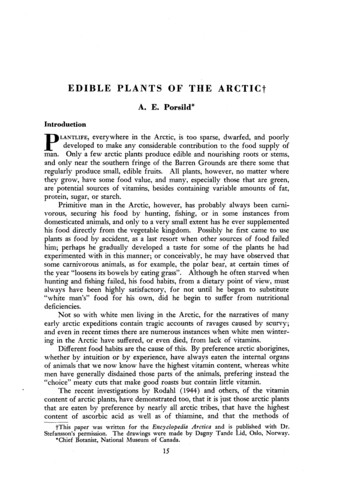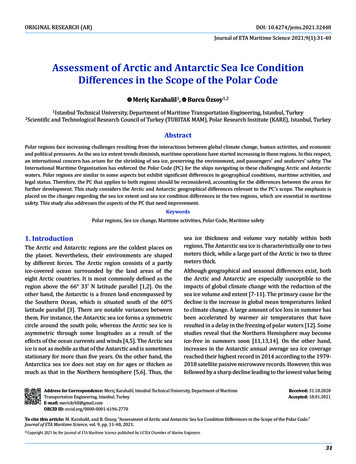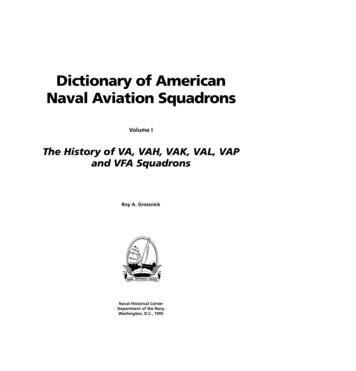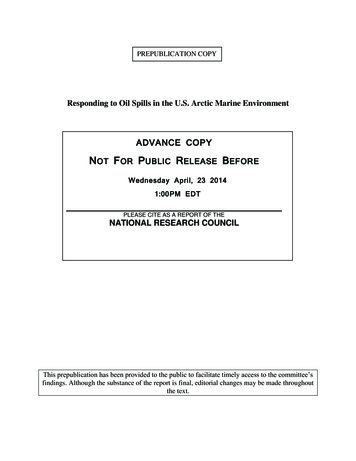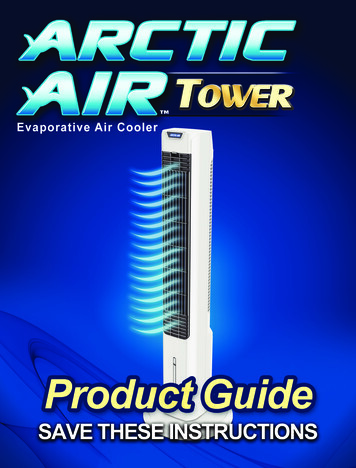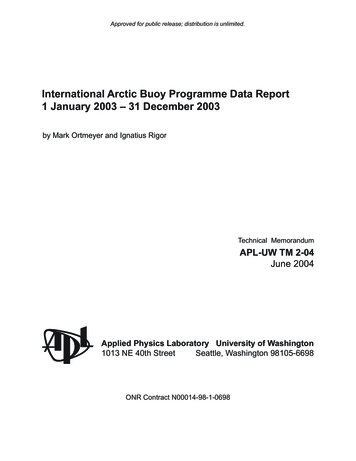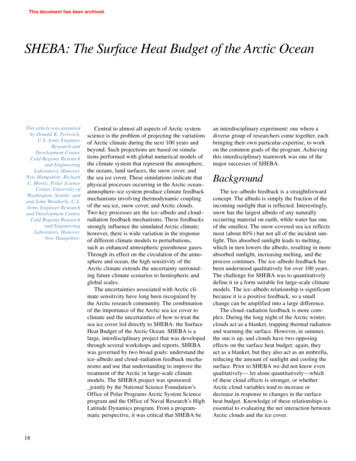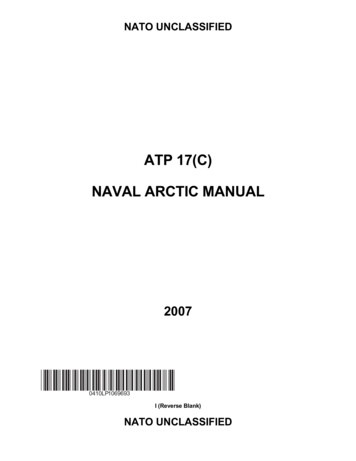
Transcription
NATO UNCLASSIFIEDATP 17(C)NAVAL ARCTIC MANUAL20070410LP1069693I (Reverse Blank)NATO UNCLASSIFIED
INTENTIONALLY BLANK
NATO-UNCLASSIFIEDATP-17(C)November 2007PUBLICATION NOTICEROUTING1. ATP-17(C), NAVAL ARCTIC MANUAL, is available in the Navy WarfareLibrary. It is effective upon receipt.2. ATP-17(C), the purpose of this publication is to provide information on theenvironment and challenges of the Arctic.Navy Warfare Library CustodianNavy Warfare Library publications must be madereadily available to all users and other interestedpersonnel within the U.S. Navy.Note to Navy Warfare Library CustodianThis notice will assist you in providing information to cognizant personnel. It is not accountable.IIaNATO-UNCLASSIFIEDORIGINAL
NATO-UNCLASSIFIEDAXP-3(C)INTENTIONALLY BLANKIIbNATO-UNCLASSIFIEDCHANGE 2
INTENTIONALLY BLANK
INTENTIONALLY BLANK
NATO-UNCLASSIFIEDATP-17(C)RECORD OF RESERVATIONS / COMMENTSCHAPTERAllRECORD OF RESERVATIONS BY NATIONSUSAChapter 9 and 16USA CommentVIINATO-UNCLASSIFIEDORIGINAL
ATP-17(C)NATO-UNCLASSIFIEDRECORD OF RESERVATIONS / COMMENTS (Cont’d)NATIONUSAUSARECORD OF RESERVATIONS BY NATIONSUSA Navy implementation plan includes the US Marine Corpsa. Discussion in Chapters 9 and 16 for prevention and treatment of coldwater immersion injuries is necessary. NATO forces should acquireproper anti-exposure gear for sailors.b. The use of cotton clothing is unsuited for cold, wet weather.Alternatives include:1. Ship-based operations: Navy issues one-piece anti-exposure suits fordeck use.2. Shore-based operations: Extended Cold Weather System (ECWS), 2ndgeneration, is the standard and includes polypropylene, fiber pile andGore-Tex layers. FM21-15 is the Army reference.c. This agreement covers the U.S. Air Force, Army, Marines and Navy.ORIGINALVIIINATO-UNCLASSIFIED
NATO-UNCLASSIFIEDATP-17(C)RECORD OF PAGE CHECKSDate CheckedBy Whom CheckedIXNATO-UNCLASSIFIEDORIGINAL
NATO-UNCLASSIFIEDATP-17(C)RECORD OF CHANGES AND AMENDMENTSIdentification of Changeor Amendment No., RegNo. (if any), and DateORIGINALDateEnteredNATOEffectiveDateBy Whom Entered (Signature;Rank, Grade or Rate; Name ofCommand)XNATO-UNCLASSIFIED
NATO-UNCLASSIFIEDATP-17(C)TABLE OF CONTENTSCHAPTER 1 - THE ARCTIC ENVIRONMENT101102103104105106General Description. 1-1Limits of Arctic Lands . 1-3Permafrost and Terrain. 1-3Permanent Land Ice . 1-5Beaches and Cliffs. 1-8Details of Coastaltopography . 1-9CHAPTER 2 - CLIMATE201202203204205206207208Introduction. 2-1Air Pressure. 2-3Principal Tracks of Cyclones and Synoptic Systems . 2-6Wind. 2-7Temperature . 2-7Fog and Visibility . 2-9Cloud . 2-10Precipitation. 2-10CHAPTER 3 - finition. 3-1Bathymetry . 3-1Water Masses. 3-3Currents. 3-4Advection Boundaries. 3-6Western North American Waters. 3-8Eastern North American Waters (North of a Line, Resolution Island - Kap Farvel). 3-8Northeast Atlantic Waters. 3-11Eurasian Coastal Waters. 3-14Eastern Siberian Coastal Waters . 3-16Central Polar Basin. 3-17Arctic Ocean Fronts. 3-23CHAPTER 4 - SEA ICE401402403404405406407Introduction. 4-1Ice Formation. 4-3Structure and Properties of Sea Ice . 4-3Annual Ice Cycle. 4-4Occurrence of Sea Ice. 4-5Ice Forecasting . 4-5Other Ice Encountered at Sea. 4-6CHAPTER 5 - GENERAL PREPARATIONS FOR ARCTIC OPERATIONS501502503504505506507508General. 5-1Topside Preparations . 5-1Ship's Boats Preparation . 5-3Mooring Lines and Anchor Gear Preparations. 5-4Engineering Preparation. 5-4Towing Considerations . 5-6Ice Preparations/Considerations . 5-6Cargo Handling Considerations . 5-7XINATO-UNCLASSIFIEDORIGINAL
ATP-17(C)NATO-UNCLASSIFIEDTABLE OF CONTENTSCHAPTER 6 - HULL, ENGINEERING AND 14615Cold-Weather Preparations. 6-1Exposed Piping and Scuppers . 6-1Hull Damage and Repair in the Ice . 6-1Stowage Space Requirements. 6-2Fresh Water Supply. 6-2Salt Water Supply. 6-2General Instructions For Machinery . 6-3Exposed Equipment . 6-3General Instructions . 6-3Insulation . 6-4Gas Cylinders . 6-4Batteries . 6-4Ship Cold Weather Soaking . 6-5Yellow Gear . 6-6Underway Replenishment . 6-7CHAPTER 7 - COMBAT SYSTEMS701702703704705706707708709710Cold-Weather Preparations. 7-1Fire Control Radars . 7-3Recoil Mechanisms . 7-3Aircraft Guns. 7-3Gun Sights and Aircraft Fire Control Equipment . 7-4Bomb Sights and Bomb Directors . 7-4Ammunition. 7-4Lubricants . 7-4Torpedoes and Torpedo Tubes. 7-4Minesweeping Gear. 7-5CHAPTER 8 - ELECTRONICS AND CHARACTERISTICS OF ELECTRONIC EMISSIONS801802803804805806807808809General Requirements . 8-1Exposed Electronic Equipment . 8-1Cold-Weather Preparations. 8-2Care of Equipment in Low Temperatures . 8-4Underwater Electronic Equipment. 8-4Portable Power Sources (For Electronic Equipment). 8-4Maintianance (Personnel Precautions) . 8-5Communication Characteristics. 8-5Arctic Anomalies. 8-6CHAPTER 9 - n. 9-1Training/Preparation . 9-1Food and Water. 9-1Cold-Weather Clothing . 9-1Personal Welfare . 9-3Frostbite. 9-3Treatment of Frostbite . 9-5Immersion Foot. 9-6Hypothermia . 9-7Snow-Blindness. 9-8ORIGINALXIINATO-UNCLASSIFIED
NATO-UNCLASSIFIEDATP-17(C)TABLE OF CONTENTS911912913914Hypoxia. 9-8Carbon-Monoxide Poisoning . 9-8Avoiding Cold-Weather Injuries. 9-8Dehydration . 9-9CHAPTER 10 - GENERAL OPERATIONS1001100210031004Ice-Breakers . 10-1Ships. 10-1Air-Cushion Vehicles . 10-2Diving . 10-2CHAPTER 11 - SHIP HANDLING IN ICE AND ICE 11111112111311141115111611171118Introduction. 11-1Non-Ice-Strengthened Ships . 11-1Indications of Ice. 11-1Signs of Open Water . 11-1Icebergs. 11-2Entering the Ice . 11-3Speed of Ships Working in Ice . 11-3Working Through Ice . 11-4Convoying in Ice . 11-5Types of Convoy. 11-5Distance Between Ships . 11-6Course and Speed of Convoy . 11-7Conducting Through Ice . 11-7Signalling Between Ice-Breakers and Escorted Ships . 11-8Stopped Ice-Breaker - Red Warning Lights and Sound Signal. 11-8Breaking Out Ships. 11-9Replenishment in Ice . 11-9Anchoring . 11-9CHAPTER 12 - ARCTIC NAVIGATION, NAVIGATIONAL AIDS AND 11121212131214121512161217General. 12-1Charts and Sailing Directions . 12-1General Reference Books . 12-1Chart Projections . 12-1Polar Grid . 12-2Magnetic Compasses . 12-3Gyro-Compasses. 12-4Azimuths. 12-4Celestial Compasses. 12-4Dead Reckoning . 12-4Astronomical Observations . 12-5Sunrise, Sunset and Twilight Phenomena . 12-5Abnormal Refraction. 12-5Echo-Sounder. 12-6Electronic Aids To Navigation . 12-7Radar As a Fixing Aid. 12-7Radar and Sonar for Ice Detection. 12-8XIIINATO-UNCLASSIFIEDORIGINAL
ATP-17(C)NATO-UNCLASSIFIEDTABLE OF CONTENTSCHAPTER 13 - ARCTIC Introduction. 13-1Air Navigation . 13-1Instruments. 13-2Electronic Equipment. 13-2Electrical . 13-3Servicing Aircraft in Cold Temperatures. 13-3Refuelling. 13-3Oil Replenishment . 13-4Cold Starting Piston Engines. 13-4Engine Lubrication. 13-4Piston Engine Shut-Down and Restarting. 13-5External Heating . 13-5Propellers . 13-5Cold Starting Jet Engines. 13-5Low-Temperature Fuel Combustion. 13-6Airframes . 13-6Flight-Deck Preparations. 13-7Flight Operations . 13-8Pre-Flight . 13-8Preparation for Flight . 13-9Anti-Icing/De-Icing . 13-9Rotary-Wing Aircraft Operations . 13-10Fixed-Wing Ski Operation . 13-10CHAPTER 14 - SUBMARINE AND ANTISUBMARINE rial Readiness. 14-1Under-Ice Procedures . 14-2Preparations for Surfacing in Pack-Ice. 14-2Surfacing Techniques. 14-3Diving in An Ice Area . 14-4Detection Capabilities. 14-4Ambient Noise in the Arctic . 14-4Acoustic Signal Propagation . 14-5Shallow Water Limitations on Submarines. 14-7CHAPTER 15 - AMPHIBIOUS OPERATIONS IN THE tion. 15-1Marginal Ice Areas. 15-1Marginal Ice Operations . 15-2Low Surf and Swell. 15-2Effects of Terrain on Amphibious Assaults . 15-2Effects of Climate and Weather. 15-3Air Operations Considerations . 15-4NBC Operations . 15-5Shipboard Considerations . 15-6ORIGINALXIVNATO-UNCLASSIFIED
NATO-UNCLASSIFIEDATP-17(C)TABLE OF CONTENTSCHAPTER 16 - 11Introduction. 16-1Cold . 16-1Person Overboard . 16-2Abandon Ship . 16-2Immersion Suits. 16-2Helicopter Survival Equipment . 16-3Emergency Aircraft Landings in the Arctic . 16-3Ocean Survival . 16-7Carbon-Monoxide Poisoning . 16-8Dangerous Arctic Animals . 16-8Wintering In. 16-8Annex A - Conversion Charts .A-1Annex B - Glossary of Ice Terms .B-1Annex C - Example Cold Weather Bill.C-1Annex D - Battery Maintenance, Equipment Safety and Chemicals Battery Maintenance.D-1Annex E - Arctic Ocean Plotting Chart .E-1List of Effective Pages . LEP-1XVNATO-UNCLASSIFIEDORIGINAL
ATP-17(C)NATO-UNCLASSIFIEDLIST OF FIGURESFigure 1-1 Boundaries of the Arctic and Subarctic Environments . 1-4Figure 1-2 Chamberain Glacier Entering Wolstenholme Fiord (Northwest Greenland) . 1-7Figure 1-3 Contemporary Arctic Glaciers (Shaded areas are glaciated). 1-9Figure 1-4 Ice--Shove Ridges, Nansen Sound, Northern Canada. 1-10Figur
1. ATP-17(C), NAVAL ARCTIC MANUAL, is available in the Navy Warfare Library. It is effective upon receipt. 2. ATP-17(C), the purpose of this publication is to provide information on the environment and challenges of the Arctic. Navy Warfare Library Custodian IIa ORIGINAL NATO-UNCLASSIFIED NATO-UNCLASSIFIED ATP-17(C)
